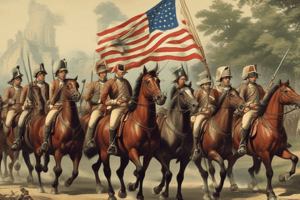Podcast
Questions and Answers
Who was Thomas Hart Benton?
Who was Thomas Hart Benton?
A zealous supporter of western interests and a senator from Missouri who opposed slavery.
What does graduation refer to in the context of land sales?
What does graduation refer to in the context of land sales?
Lowering of land prices gradually for lands that go unsold on the market.
Who was George McDuffie?
Who was George McDuffie?
A congressman from South Carolina who was an extreme advocate for states' rights.
What is cession in the context of land distribution?
What is cession in the context of land distribution?
Who was John Randolph?
Who was John Randolph?
What was Edward Livingston's contribution to the Webster-Hayne debate?
What was Edward Livingston's contribution to the Webster-Hayne debate?
Who was Robert Y. Hayne?
Who was Robert Y. Hayne?
What did Daniel Webster represent in the debate?
What did Daniel Webster represent in the debate?
Who was Denmark Vesey?
Who was Denmark Vesey?
What was the significance of the Webster-Hayne debate?
What was the significance of the Webster-Hayne debate?
What was the Foote Resolution?
What was the Foote Resolution?
What was the difference between the tariff of 1828 and the tariff of 1832?
What was the difference between the tariff of 1828 and the tariff of 1832?
What was the purpose of the force bill?
What was the purpose of the force bill?
Why did Jackson oppose nullification?
Why did Jackson oppose nullification?
Flashcards are hidden until you start studying
Study Notes
Key Figures and Concepts in the Webster-Hayne Debate
-
Thomas Hart Benton: Senator from Missouri; advocated for western interests and proposed the graduation act; opposed slavery; viewed the Foote Resolution as a threat to westward migration.
-
Graduation: A policy aimed at gradually lowering the prices of unsold lands, making them more accessible to settlers.
-
George McDuffie: Congress member from South Carolina; an extreme proponent of states' rights; faced personal injury in a duel and later died.
-
Cession: The concept of transferring federally controlled lands to individual states for distribution and management.
-
John Randolph: Leader of the "Old Republicans" party; introduced the idea of cession, emphasizing strict interpretations of states' rights.
-
Edward Livingston: Formulated a compromise between Webster and Hayne; proposed the idea of divided sovereignty, echoing Jackson's views.
-
Robert Y. Hayne: Vocal advocate for states' rights from South Carolina, representing southern interests during the Webster-Hayne debate.
-
Daniel Webster: Promoted an ultranationalist agenda during the debate, focusing on preserving the Union and strengthening federal authority.
-
Denmark Vesey: A free black man who attempted to orchestrate a slave rebellion in Charleston; his execution heightened southern fears of northern influence on slavery.
Significance of the Webster-Hayne Debate
-
Regional Tensions: The North aimed to limit westward land sales, while the South opposed these efforts, believing it would enhance federal control and weaken state rights.
-
Control of Western Development: Debate centered around whether revenues from land sales should go to the federal government or the states.
-
Foote Resolution: Proposed by Samuel A. Foote to halt public land sales to new settlers; spurred a critical response from Daniel Webster, warning of the dangers of state autonomy in interpreting laws, which could lead to civil conflict.
Tariffs and Federal Authority
-
Tariff of 1828 vs 1832: The 1828 tariff was excessively high; the 1832 tariff lowered rates to 1816 levels but still dissatisfied the South, prompting further reductions by Jackson in 1833.
-
Force Bill: Authorized the president to deploy military force to ensure tariff collection, reflecting the growing tensions between state and federal powers.
Jackson's Stance on Nullification
- Opposition to Nullification: Although Jackson supported states' rights, he viewed nullification as a threat to national unity, considering it a step toward potential secession.
Studying That Suits You
Use AI to generate personalized quizzes and flashcards to suit your learning preferences.





